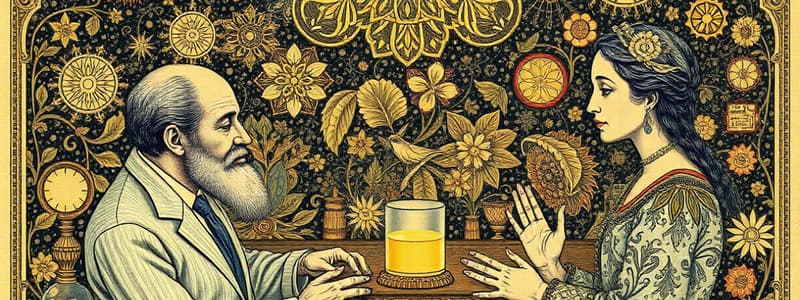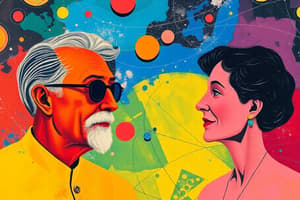Podcast
Questions and Answers
Which of the following best describes Fred Hoyle's contribution to astrophysics?
Which of the following best describes Fred Hoyle's contribution to astrophysics?
- He discovered organic molecules in comets, proving they brought life to Earth.
- He proposed that nuclear reactions within stars create most chemical elements. (correct)
- He disproved the Big Bang theory and solidified the steady state theory.
- He developed a propulsion system for unmanned spacecraft.
Katherine Johnson's work at NACA/NASA primarily involved:
Katherine Johnson's work at NACA/NASA primarily involved:
- Designing rocket engines for the Space Shuttle program.
- Manually calculating trajectories for space missions. (correct)
- Developing propulsion systems for unmanned spacecraft.
- Investigating the effects of X-rays on chromosomes.
Irene Uchida's research primarily focused on:
Irene Uchida's research primarily focused on:
- The origin of elements in stars.
- The impact of genes and chromosomes on health conditions. (correct)
- Calculating trajectories for space missions.
- Developing rocket designs for US Moon missions.
Yvonne Brill is best known for what invention?
Yvonne Brill is best known for what invention?
Assuming Fred Hoyle's steady state theory was correct, which of the following would have to be true?
Assuming Fred Hoyle's steady state theory was correct, which of the following would have to be true?
Which scientist's work directly led to international agreements limiting the use of CFCs?
Which scientist's work directly led to international agreements limiting the use of CFCs?
Vera Rubin's observations of galactic rotation curves provided evidence for which of the following?
Vera Rubin's observations of galactic rotation curves provided evidence for which of the following?
The work of which scientist clarified the processes behind short- and long-term memory, demonstrating their applicability to humans through studies on sea slugs?
The work of which scientist clarified the processes behind short- and long-term memory, demonstrating their applicability to humans through studies on sea slugs?
Donna Strickland's Nobel Prize-winning work on chirped pulse amplification (CPA) has NOT directly contributed to which of the following applications?
Donna Strickland's Nobel Prize-winning work on chirped pulse amplification (CPA) has NOT directly contributed to which of the following applications?
Imagine that a new particle is discovered at the LHC, but, despite exhibiting mass, it does not interact with the Higgs field. According to established theory, what far-reaching implication would this have?
Imagine that a new particle is discovered at the LHC, but, despite exhibiting mass, it does not interact with the Higgs field. According to established theory, what far-reaching implication would this have?
Flashcards
Fred Hoyle
Fred Hoyle
British astrophysicist known for work on the origin of elements in stars and the steady-state theory.
Katherine Johnson
Katherine Johnson
American mathematician who calculated trajectories for early space missions.
Irene Uchida
Irene Uchida
Canadian medical geneticist who studied the effects of genes and chromosomes on health.
Yvonne Brill
Yvonne Brill
Signup and view all the flashcards
Abdus Salam
Abdus Salam
Signup and view all the flashcards
Electroweak Theory
Electroweak Theory
Signup and view all the flashcards
Vera Rubin's Dark Matter Discovery
Vera Rubin's Dark Matter Discovery
Signup and view all the flashcards
Higgs Mechanism
Higgs Mechanism
Signup and view all the flashcards
Mario Molina's CFC Research
Mario Molina's CFC Research
Signup and view all the flashcards
Telomeres and Telomerase
Telomeres and Telomerase
Signup and view all the flashcards
Study Notes
- Science has become both increasingly diverse and increasingly connected.
- Researchers across the globe collaborate to increase human knowledge in every field
- Researchers seek to bring their different disciplines closer together in pursuit of bigger, broader, more useful theories.
Fred Hoyle (1915–2001)
- British astrophysicist who worked on the origin of elements in stars.
- Postulated that most chemical elements could be created step-by-step by nuclear reactions within large stars.
- A proponent of the steady state theory, which states that as the Universe expands, its average density is kept constant as new matter is continuously created.
- Coined the phrase "Big Bang" disparagingly for the main rival theory during a popular radio talk.
- The steady state theory was largely discredited in the 1960s.
- Took particular interest in the presence of organic molecules in comets, believing they brought life to Earth.
Katherine Johnson (1918–)
- Award-winning American mathematician who played a key role in calculating the trajectory for many space missions.
- Calculated the trajectory for the mission of Alan Shepard, the first American in space.
- Began work at the National Advisory Committee for Aeronautics (NACA), a forerunner of NASA, in 1953.
- Manually carried out calculations for the engineers.
- Helped plan the launch site and flight path for the Apollo 11 Moon mission in 1969.
- Later worked on the US space shuttle program and retired from NASA in 1986.
Irene Uchida (1917–2013)
- Canadian medical geneticist who instigated work on how genes and chromosomes affect health.
- Investigated chromosome differences in various genetic conditions and congenital abnormalities.
- Studied congenital heart disease and Down syndrome, in which people have an extra chromosome (47 rather than 46).
- Examined how X-rays affect chromosomes.
Yvonne Brill (1924–2013)
- Born near Winnipeg, Canada, started work with the Douglas Aircraft company in 1945.
- Invented a propulsion system that keeps unmanned spacecraft in stationary orbit.
- Worked on thrusters for weather satellites, rocket designs used in US Moon missions, and the Mars observer.
- Worked for NASA from 1981 to 1983 on a rocket engine for the space shuttle.
Abdus Salam (1926–1996)
- Born in Pakistan, studied mathematics and physics at the University of Cambridge, UK.
- Proposed the electroweak theory, which explains how the weak interaction between subatomic particles works and how it could be unified with the electromagnetic force.
- His theory postulated the existence of messenger particles for the weak interaction.
- His theories were proved correct at CERN in 1973.
- Jointly awarded the Nobel Prize in Physics with Sheldon Lee Glashow and Steven Weinberg in 1979.
Vera Rubin (1928–2016)
- Discovered that stars orbiting in the outer part of a spiral galaxy travel as fast as those close to the center in the 1970s.
- This implied that each galaxy had a halo of invisible matter whose gravitational force affected the outer stars, contrary to Newton’s laws of gravity.
- In 1970, showed this to be true of the Andromeda Galaxy and by 1985, she had examined 60 spiral galaxies.
- This work convinced astronomers that dark matter exists
- Received the National Medal of Science in 1993.
Peter Higgs (1929–)
- Born in Newcastle, England, studied physics at King’s College London.
- Began work at the University of Edinburgh in 1960.
- Best known for developing a theory that explains the origin of the mass of elementary particles (subatomic particles).
- These particles obtain their masses by interacting with a field, called the Higgs field, that permeates space.
- Predicted that this field should produce its own type of particle, which has since become known as the Higgs boson.
- The search for the Higgs boson spawned the Large Hadron Collider (LHC) at CERN.
- Scientists at CERN discovered a particle with the predicted characteristics of the Higgs boson in 2012.
- Received the Nobel Prize in Physics in 2013, sharing it with François Englert for the work they carried out in 1964.
Eric Kandel (1929–)
- Born in Vienna in 1929, fled with his family to the US due to anti-Semitism.
- Studied medicine at New York University, receiving his degree in 1956.
- Awarded the Nobel Prize in Physiology or Medicine in 2000 for work on the role synapses play in memory and learning.
- Helped to clarify the different processes behind short- and long-term memory.
- Showed that the different processes behind short- and long-term memory are equally applicable in humans.
Mario J. Molina (1943–)
- Born in Mexico City, studied to become a chemical engineer.
- Showed that CFCs (chlorofluorocarbon compounds) released from aerosols, foams, and refrigerants destroy the ozone layer in 1974.
- Led directly to banning or limiting the use of CFCs.
- Earned a share of the 1995 Nobel Prize in Chemistry.
Lap-Chee Tsui (1950–)
- Canadian medical geneticist born in Shanghai, moved to Canada in 1977.
- Jointly found the fault in the gene responsible for cystic fibrosis.
- Identification of the faulty gene paved the way for new treatment options based on correcting the gene or replacing it.
Mae Carol Jemison (1956–)
- First African American woman to travel in space, going into orbit in the space shuttle Endeavour in 1992.
- Graduated from medical school in 1981 before serving as a medical officer with the Peace Corps in West Africa.
- Became one of the 15 candidates selected from more than 2,000 applicants to train as an astronaut in 1987.
- Was the science mission specialist on the space shuttle and a coinvestigator of two bone cell research experiments.
Donna Strickland (1959–)
- Canadian optical physicist who paved the way for the shortest and most intense laser pulses ever created.
- Developed a technique called chirped pulse amplification (CPA) along with Gérard Mourou from France in 1985.
- Awarded the Nobel Prize in Physics with Mourou in 2018 for CPA.
- Became associate professor in the Department of Physics and Astronomy at the University of Waterloo in 1997.
- CPA has several uses, including in laser eye surgery and in some cancer therapies.
Carol Greider (1961–)
- American molecular biologist whose research has been on telomeres and the enzyme telomerase.
- Telomeres are the segments of DNA that occur at the ends of chromosomes and play an important role in cell life span.
- Awarded the Nobel Prize in Physiology or Medicine in 2009 with Elizabeth Blackburn and Jack W. Szostak.
- Found that inhibiting the telomerase in cancer cells slows tumor growth, making it a potential anticancer drug development.
Studying That Suits You
Use AI to generate personalized quizzes and flashcards to suit your learning preferences.
Description
A brief overview of Fred Hoyle and Katherine Johnson's contribution to science. Fred Hoyle was a British astrophysicist noted for his work on the origin of elements in stars. Katherine Johnson is an award-winning American mathematician known for her calculations of orbital mechanics.





